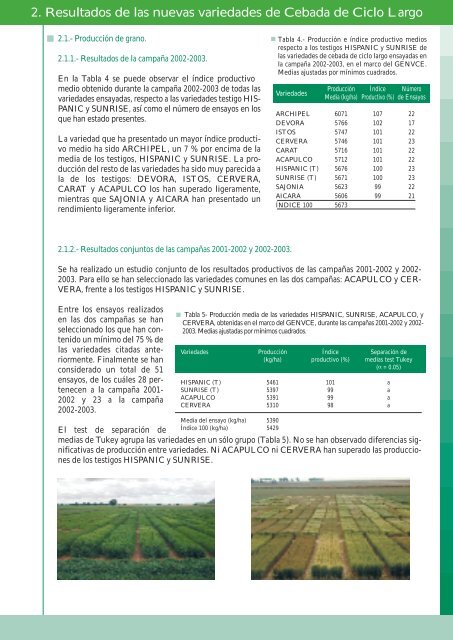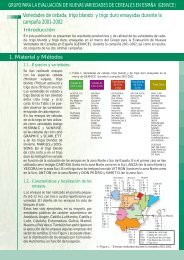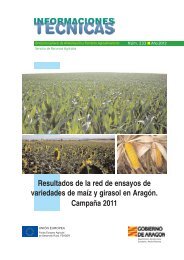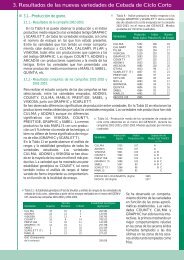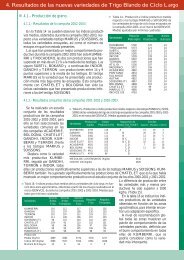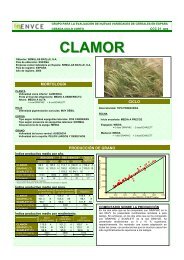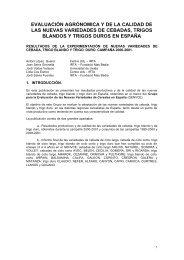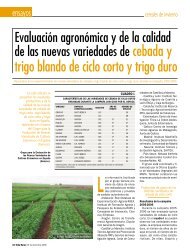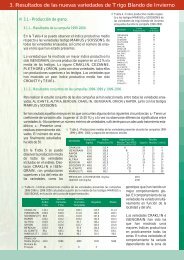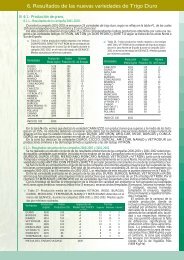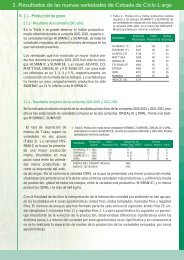CEREAL DE INVIERNO. Cebada de ciclo largo - GENVCE
CEREAL DE INVIERNO. Cebada de ciclo largo - GENVCE
CEREAL DE INVIERNO. Cebada de ciclo largo - GENVCE
Create successful ePaper yourself
Turn your PDF publications into a flip-book with our unique Google optimized e-Paper software.
2. Resultados <strong>de</strong> las nuevas varieda<strong>de</strong>s <strong>de</strong> <strong>Cebada</strong> <strong>de</strong> Ciclo Largo<br />
2.1.- Producción <strong>de</strong> grano.<br />
2.1.1.- Resultados <strong>de</strong> la campaña 2002-2003.<br />
En la Tabla 4 se pue<strong>de</strong> observar el índice productivo<br />
medio obtenido durante la campaña 2002-2003 <strong>de</strong> todas las<br />
varieda<strong>de</strong>s ensayadas, respecto a las varieda<strong>de</strong>s testigo HIS-<br />
PANIC y SUNRISE, así como el número <strong>de</strong> ensayos en los<br />
que han estado presentes.<br />
La variedad que ha presentado un mayor índice productivo<br />
medio ha sido ARCHIPEL, un 7 % por encima <strong>de</strong> la<br />
media <strong>de</strong> los testigos, HISPANIC y SUNRISE. La producción<br />
<strong>de</strong>l resto <strong>de</strong> las varieda<strong>de</strong>s ha sido muy parecida a<br />
la <strong>de</strong> los testigos: <strong>DE</strong>VORA, ISTOS, CERVERA,<br />
CARAT y ACAPULCO los han superado ligeramente,<br />
mientras que SAJONIA y AICARA han presentado un<br />
rendimiento ligeramente inferior.<br />
Tabla 4.- Producción e índice productivo medios<br />
respecto a los testigos HISPANIC y SUNRISE <strong>de</strong><br />
las varieda<strong>de</strong>s <strong>de</strong> cebada <strong>de</strong> <strong>ciclo</strong> <strong>largo</strong> ensayadas en<br />
la campaña 2002-2003, en el marco <strong>de</strong>l <strong>GENVCE</strong>.<br />
Medias ajustadas por mínimos cuadrados.<br />
Varieda<strong>de</strong>s<br />
Producción Índice Número<br />
Media (kg/ha) Productivo (%) <strong>de</strong> Ensayos<br />
ARCHIPEL 6071 107 22<br />
<strong>DE</strong>VORA 5766 102 17<br />
ISTOS 5747 101 22<br />
CERVERA 5746 101 23<br />
CARAT 5716 101 22<br />
ACAPULCO 5712 101 22<br />
HISPANIC (T) 5676 100 23<br />
SUNRISE (T) 5671 100 23<br />
SAJONIA 5623 99 22<br />
AICARA 5606 99 21<br />
ÍNDICE 100 5673<br />
2.1.2.- Resultados conjuntos <strong>de</strong> las campañas 2001-2002 y 2002-2003.<br />
Se ha realizado un estudio conjunto <strong>de</strong> los resultados productivos <strong>de</strong> las campañas 2001-2002 y 2002-<br />
2003. Para ello se han seleccionado las varieda<strong>de</strong>s comunes en las dos campañas: ACAPULCO y CER-<br />
VERA, frente a los testigos HISPANIC y SUNRISE.<br />
Entre los ensayos realizados<br />
en las dos campañas se han<br />
seleccionado los que han contenido<br />
un mínimo <strong>de</strong>l 75 % <strong>de</strong><br />
las varieda<strong>de</strong>s citadas anteriormente.<br />
Finalmente se han<br />
consi<strong>de</strong>rado un total <strong>de</strong> 51<br />
ensayos, <strong>de</strong> los cuáles 28 pertenecen<br />
a la campaña 2001-<br />
2002 y 23 a la campaña<br />
2002-2003.<br />
Tabla 5- Producción media <strong>de</strong> las varieda<strong>de</strong>s HISPANIC, SUNRISE, ACAPULCO, y<br />
CERVERA, obtenidas en el marco <strong>de</strong>l <strong>GENVCE</strong>, durante las campañas 2001-2002 y 2002-<br />
2003. Medias ajustadas por mínimos cuadrados.<br />
Varieda<strong>de</strong>s Producción Índice Separación <strong>de</strong><br />
(kg/ha) productivo (%) medias test Tukey<br />
(α = 0.05)<br />
HISPANIC (T) 5461 101 a<br />
SUNRISE (T) 5397 99 a<br />
ACAPULCO 5391 99 a<br />
CERVERA 5310 98 a<br />
Media <strong>de</strong>l ensayo (kg/ha) 5390<br />
Índice 100 (kg/ha) 5429<br />
El test <strong>de</strong> separación <strong>de</strong><br />
medias <strong>de</strong> Tukey agrupa las varieda<strong>de</strong>s en un sólo grupo (Tabla 5). No se han observado diferencias significativas<br />
<strong>de</strong> producción entre varieda<strong>de</strong>s. Ni ACAPULCO ni CERVERA han superado las producciones<br />
<strong>de</strong> los testigos HISPANIC y SUNRISE.
La variedad que ha presentado<br />
una menor estabilidad<br />
genotípica es el testigo HIS-<br />
PANIC (Tabla 6). HISPA-<br />
NIC es la variedad que se ha<br />
situado en un mayor número<br />
<strong>de</strong> casos en el tercil superior.<br />
En el análisis <strong>de</strong> rangos se<br />
observa una variación <strong>de</strong>l<br />
comportamiento <strong>de</strong> todas las<br />
varieda<strong>de</strong>s en función <strong>de</strong> la<br />
localidad <strong>de</strong> ensayo, lo que<br />
explicaría en parte que no se<br />
hayan observado diferencias<br />
<strong>de</strong> producción significativas<br />
entre varieda<strong>de</strong>s.<br />
Tabla 7- Fecha <strong>de</strong> espigado y nivel <strong>de</strong> afectación por<br />
enfermeda<strong>de</strong>s foliares <strong>de</strong> las varieda<strong>de</strong>s <strong>de</strong> cebada <strong>de</strong><br />
<strong>ciclo</strong> <strong>largo</strong>, ensayadas durante la campaña 2002-2003, en<br />
el marco <strong>de</strong>l <strong>GENVCE</strong>.<br />
Espigado Oidio Rincosporiosis<br />
Varieda<strong>de</strong>s Respecto a (Escala (Escala<br />
Sunrise (días) visual 0-9) visual 0-9)<br />
ACAPULCO +1 5 5<br />
AICARA - 3 5 3<br />
ARCHIPEL +2 5 5<br />
CARAT +6 4 3<br />
CERVERA +4 6 3<br />
<strong>DE</strong>VORA +8 4 4<br />
HISPANIC (T) 0 6 4<br />
ISTOS +7 4 2<br />
SAJONIA +3 6 4<br />
SUNRISE (T) +5 6 4<br />
Nº <strong>de</strong> Ensayos 14 6 6<br />
Tabla 8.- Altura, encamado, peso <strong>de</strong> 1000 granos y peso específico <strong>de</strong><br />
las varieda<strong>de</strong>s <strong>de</strong> cebada <strong>de</strong> <strong>ciclo</strong> <strong>largo</strong>, ensayadas durante la campaña<br />
2002-2003, en el marco <strong>de</strong>l <strong>GENVCE</strong>.<br />
Varieda<strong>de</strong>s<br />
Peso <strong>de</strong> 1000 Peso<br />
Altura Encamado Granos Específico<br />
(cm) (%) (g) (kg/hl)<br />
ACAPULCO 72 35 43 68<br />
AICARA 82 0 41 72<br />
ARCHIPEL 74 3 39 69<br />
CARAT 72 8 41 68<br />
CERVERA 79 38 41 67<br />
<strong>DE</strong>VORA 71 15 40 65<br />
HISPANIC (T) 70 73 41 65<br />
ISTOS 75 53 39 67<br />
SAJONIA 78 10 46 68<br />
SUNRISE (T) 74 41 36 67<br />
Nº Ensayos 17 4 10 12<br />
Tabla 6.- Estabilidad genotípica (Test <strong>de</strong> Shukla) y análisis <strong>de</strong> terciles <strong>de</strong> las varieda<strong>de</strong>s<br />
HISPANIC, SUNRISE, ACAPULCO, y CERVERA, obtenidas en el marco <strong>de</strong>l<br />
<strong>GENVCE</strong>, durante las campañas 2001-2002 y 2002-2003.<br />
Terciles<br />
Estabilidad Genotípica<br />
Varieda<strong>de</strong>s Superior Mediano Inferior (kg/ha) 2 x10 -3<br />
HISPANIC (T) 25 17 9 468,151<br />
SUNRISE (T) 8 34 9 219,468<br />
ACAPULCO 8 27 11 245,392<br />
CERVERA 10 24 10 231,068<br />
GXE (COMPONENTE<br />
<strong>DE</strong> LA VARIANZA) 296,825<br />
2.2.- Variables agronómicas.<br />
En la Tabla 7 se pue<strong>de</strong>n observar los<br />
datos <strong>de</strong> espigado, nivel <strong>de</strong> ataque <strong>de</strong><br />
oidio y rincosporiosis <strong>de</strong> todas las varieda<strong>de</strong>s<br />
ensayadas.<br />
La variedad <strong>de</strong> espigado más precoz ha<br />
sido AICARA, 3 días antes que el testigo<br />
HISPANIC. Las varieda<strong>de</strong>s ACA-<br />
PULCO, ARCHIPEL, CERVERA y<br />
SAJONIA han espigado entre 1 y 4 días<br />
<strong>de</strong>spués que HISPANIC. Las varieda<strong>de</strong>s<br />
CARAT, <strong>DE</strong>VORA e ISTOS han<br />
presentado un espigado más tardío,<br />
entre 6 y 8 días <strong>de</strong>spués que HISPA-<br />
NIC.<br />
El conjunto <strong>de</strong> las varieda<strong>de</strong>s han presentado<br />
un nivel <strong>de</strong> ataque por oidio<br />
similar. Todas las varieda<strong>de</strong>s se han<br />
visto afectadas por rincosporiosis, <strong>de</strong>stacando<br />
la variedad ISTOS como las<br />
menos afectada.<br />
En la Tabla 8 se pue<strong>de</strong>n observar los<br />
datos <strong>de</strong> altura, encamado, peso <strong>de</strong>l<br />
grano y peso específico <strong>de</strong> todas las<br />
varieda<strong>de</strong>s ensayadas.<br />
Las varieda<strong>de</strong>s que han mostrado una<br />
mayor altura son AICARA, CERVERA<br />
y SAJONIA. La variedad que se ha visto<br />
más afectada por encamado ha sido<br />
HISPANIC, seguida por ISTOS. Por el<br />
contrario, ARCHIPEL, CARAT y<br />
SAJONIA se han comportado como<br />
muy resistentes frente al encamado; la<br />
variedad AICARA no ha presentado<br />
problemas <strong>de</strong> encamado en ningún<br />
ensayo.<br />
Los pesos específicos más bajos se han<br />
observado en las varieda<strong>de</strong>s <strong>DE</strong>VORA<br />
e HISPANIC, mientras que AICARA<br />
ha presentado un valor sensiblemente<br />
mayor.


